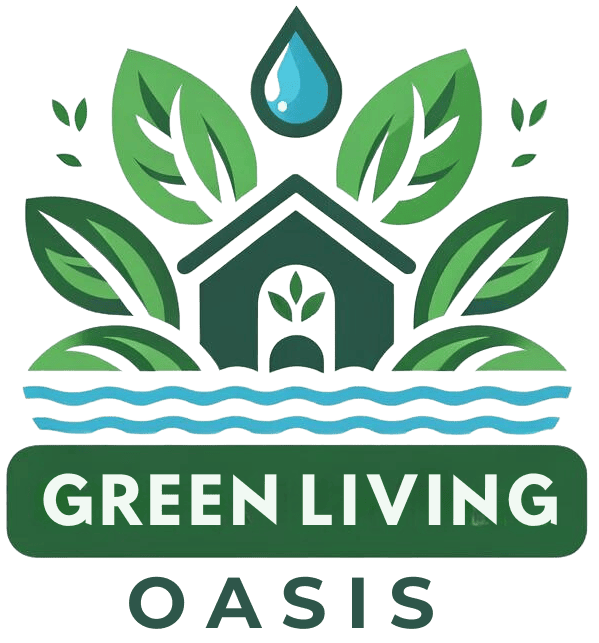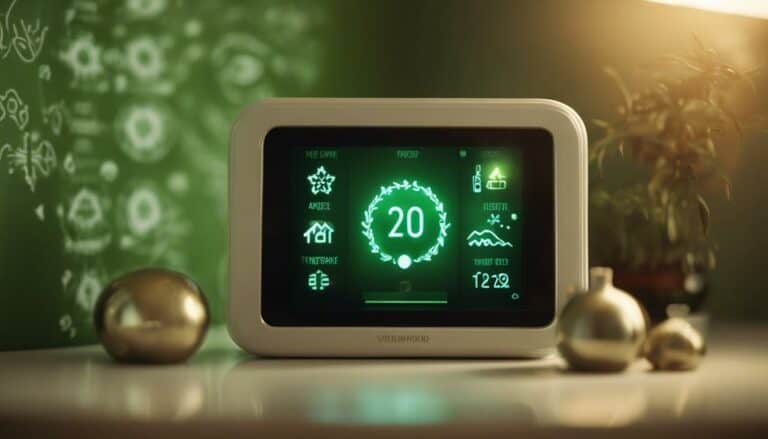Have you ever thought about how your thermostat settings could be the key to a greener lifestyle?
You're in the right place if you're looking to shave off a significant chunk from your energy bills and reduce your carbon footprint.
By mastering the art of thermostat presets, you can guarantee your home is both comfortable and energy-efficient.
We'll explore the ideal temperature ranges for different seasons, the magic of programmable and smart thermostats, and some effective techniques to get the most out of your heating and cooling systems.
Stick around to reveal the secrets to maximizing your energy savings and making a positive impact on the planet.
Key Takeaways
- Programmable and smart thermostats can reduce annual energy costs by up to 23%.
- Seasonal adjustments, like 78°F in summer and 68°F in winter, optimize energy use.
- Small temperature adjustments of 4°F can significantly save energy and costs.
- Regular thermostat personalization aligns comfort with sustainable energy savings.
Why Optimize Settings
Optimizing your thermostat settings can slash your energy bills by up to 10% annually, offering both financial relief and a greener lifestyle. With heating and cooling consuming about half of your home's energy, becoming more efficient with your thermostat use is key.
You don't just save money; you also reduce your environmental footprint. By adjusting your thermostat to balance comfort with energy savings, you're taking a significant step towards combating climate change. It's a straightforward change with powerful results, ensuring you stay cozy without overworking your heating system.
Ideal Temperature Range
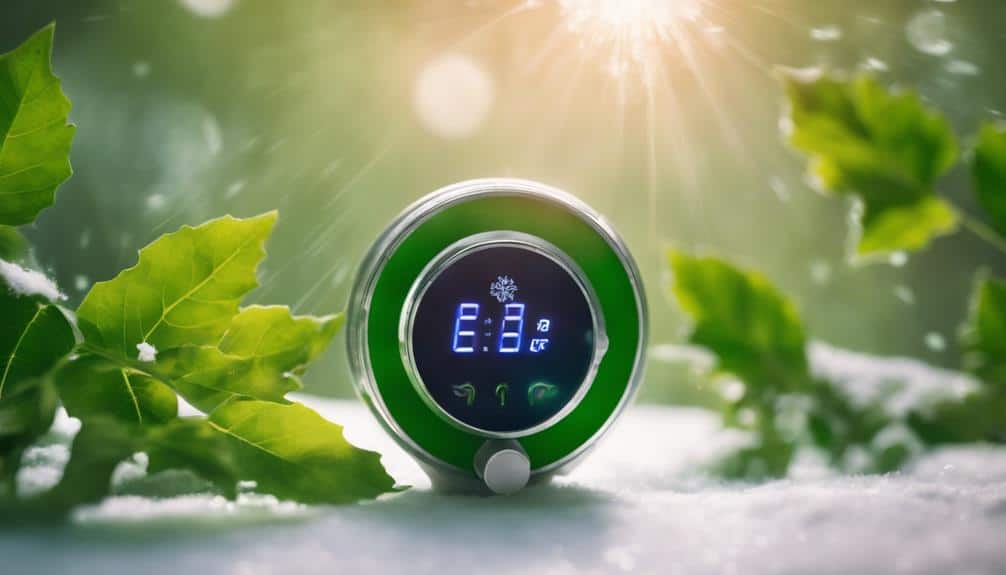
Now that you're familiar with why optimizing your thermostat settings is essential, let's explore the ideal temperature range for your home.
You'll see how adjusting your thermostat according to the season can't only enhance your energy efficiency but also strike the perfect balance between comfort and conservation.
It's about finding that sweet spot where you're saving on your bills without sacrificing your comfort.
Optimal Seasonal Temperature Settings
To live greener, adjusting your thermostat to the ideal temperature range each season can greatly cut your energy use.
In winter, aim for a cozy 68°F during the day, balancing comfort and energy efficiency. At night, drop it to 63-65°F to reduce heating costs while you're snug in bed.
Come summer, set it at 78°F for a good mix of comfort and savings. If you'll be out for a few hours, hike it up to 85-88°F to lower cooling costs.
As spring blooms, a day setting of 78°F keeps things pleasant, and when fall paints the leaves, 68°F guarantees both comfort and efficiency.
These seasonal thermostat settings are your key to a greener, more cost-effective home.
Energy Efficiency Benefits
Understanding the ideal temperature range for your home isn't just about comfort; it's also about harnessing energy efficiency benefits. By setting your thermostat to 78°F in summer, you're not just staying cool; you're also reducing cooling costs.
Similarly, lowering the thermostat to 68°F during winter strikes the perfect balance between warmth and energy efficiency. Implementing slight adjustments, like changing the thermostat by 4°F when you're asleep or away, can lead to significant energy savings.
This approach to thermostat settings guarantees you're maintaining a perfect temperature range, which reduces energy consumption and lessens your environmental impact. By carefully selecting thermostat presets, you're not only contributing to a greener lifestyle but also achieving a harmonious blend of comfort and energy savings.
Comfort Vs. Conservation Balance
Balancing comfort and conservation in your home starts with setting your thermostat to the ideal temperature range for each season. In winter, aim for 68°F (20°C) to strike a perfect balance between warmth and energy savings. During summer, 78°F (25°C) guarantees comfort without skyrocketing cooling costs.
Adjusting your thermostat settings by 4°F higher at night in summer and 4°F lower in winter optimizes energy usage further. When away, raising the temperature to 85-88°F in summer and lowering it to 60-62°F in winter can significantly conserve energy.
Following these recommended ranges allows you to enjoy a cozy home environment while keeping your energy usage—and bills—in check. It's all about finding that sweet spot between comfort and conservation.
Programmable Thermostats
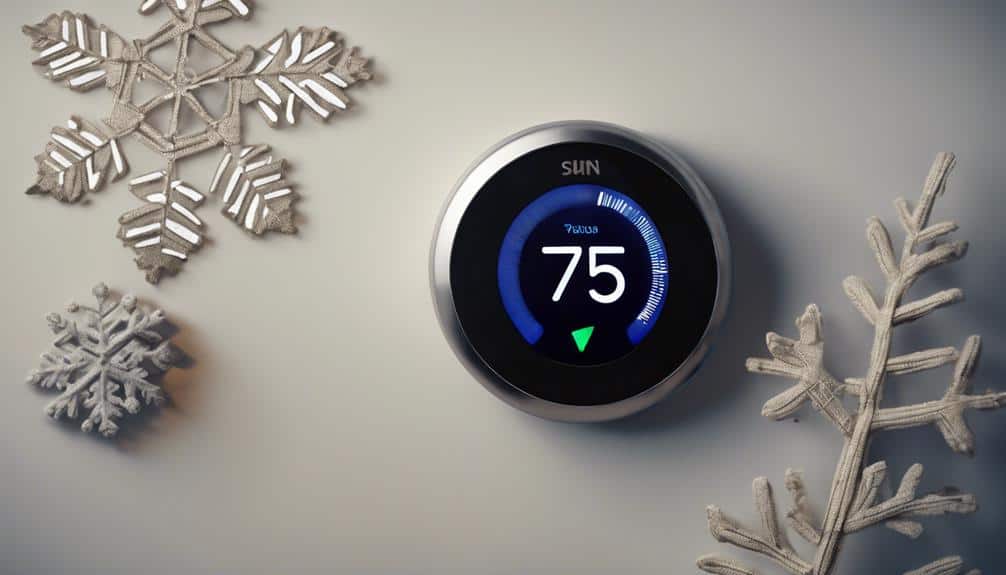
Programmable thermostats let you cut energy costs by up to 10% annually, adjusting your home's temperature to fit your schedule perfectly. They're not just about saving money; they're your partners in greener living. By setting customized schedules, you're optimizing energy usage, which contributes noticeably to sustainability.
| Feature | Benefit | Impact on Sustainability |
|---|---|---|
| Customized Schedules | Matches your lifestyle | Reduces unnecessary heating/cooling |
| Wi-Fi Connectivity | Remote temperature adjustments | Enhances convenience, prevents waste |
| Energy Savings | Up to 10% annually | Decreases overall energy consumption |
Embracing programmable thermostats means you're not just tweaking your temperature settings; you're actively participating in a movement towards greener living. It's a simple switch with profound effects on reducing energy consumption and promoting a sustainable future.
Smart Thermostat Power
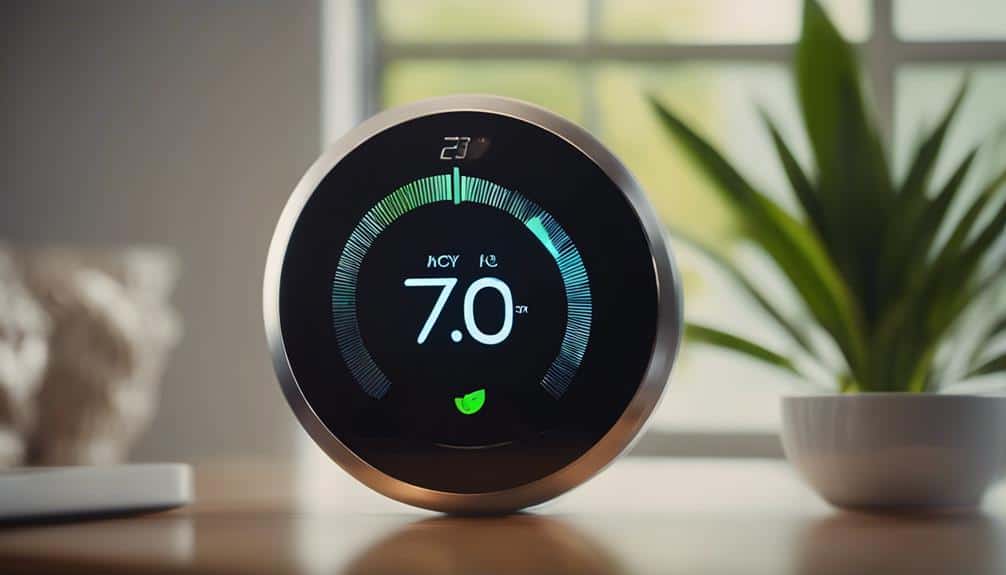
Building on the foundation of programmable thermostats, smart thermostats take energy savings and convenience to the next level. You're not just adjusting temperatures; you're adapting your home to your life. Imagine slashing your heating and cooling costs by up to 23% annually. That's not just good for your wallet; it's a step forward in green living.
- Personalized scheduling taps into your occupancy patterns, ensuring comfort when you're home and savings when you're not.
- Remote control via smartphone apps puts the power of adjustments in your palm, wherever you are.
- Energy reports reveal insights into your usage, highlighting optimization opportunities for even greater efficiency.
Smart thermostats bridge the gap between smart home integration and energy efficiency, crafting a living space that's not only smarter but also more sustainable.
Mastering Your Thermostat
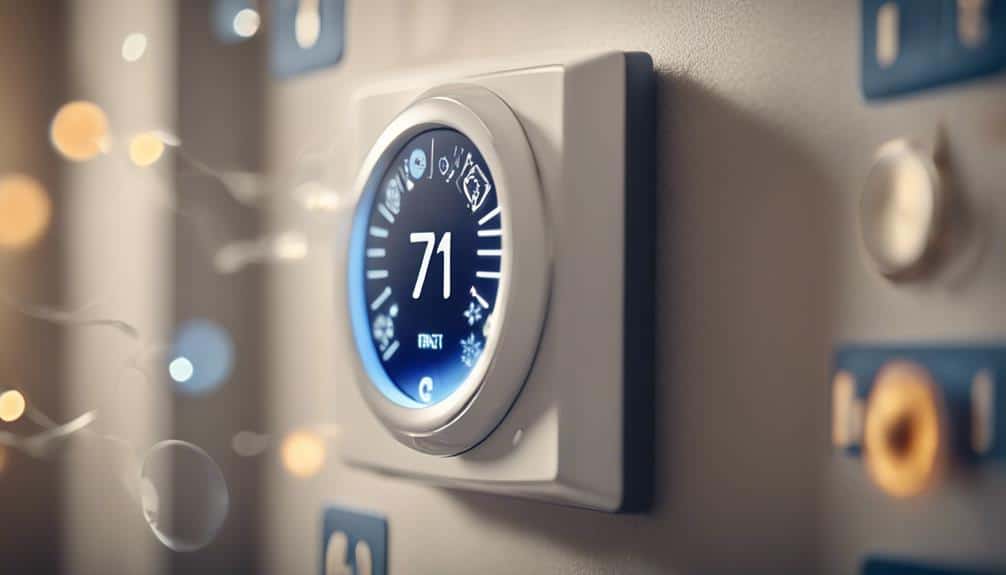
Let's tackle how you can master your thermostat for greener living.
By understanding the basics, optimizing your temperature settings, and scheduling for efficiency, you're on your way to significant savings.
These steps won't only lower your bills but also reduce your carbon footprint, making your home both smarter and more sustainable.
Understanding Thermostat Basics
Mastering your thermostat begins with understanding the essentials of how it controls your home's temperature for efficiency and comfort. Thermostats, the brains of HVAC systems, use sensors to gauge room temperatures, ensuring your space is exactly how you like it while leaning into energy efficiency and cost savings.
Here's why getting to know your thermostat matters:
- Energy Efficiency: Adjusting thermostat settings for occupancy and time saves energy.
- Cost Savings: Regular maintenance of HVAC systems and ensuring proper insulation optimizes performance.
- Comfort and Greener Living: Finding the right balance between comfort and energy efficiency paves the way for a sustainable lifestyle.
Optimizing Temperature Settings
Diving into the heart of greener living, optimizing your thermostat settings can greatly cut energy costs and reduce your carbon footprint. Set your thermostat to 68°F (20°C) in winter and 78°F (25°C) in summer for best energy usage.
By lowering the thermostat at night or when you're away, you'll tap into additional energy savings. Customizing temperature thresholds based on seasonal needs guarantees you stay comfortable while reducing energy consumption.
Programmable thermostats are your best ally, allowing for customized schedules that automatically adjust temperatures for maximum energy efficiency. Mastering these settings not only fosters greener living but also brings about significant energy savings.
It's all about smart, strategic adjustments for a more sustainable home.
Scheduling for Efficiency
After optimizing your thermostat's temperature settings, the next step is to schedule these adjustments for peak efficiency, ensuring you're saving energy and money without sacrificing comfort. Investing in a programmable thermostat is your ally in mastering thermostat settings for both personalized comfort and efficient energy usage. Programmable thermostats offer the convenience of automatically adjusting your home's temperature, making scheduling for efficiency a breeze.
- Setting your thermostat correctly can save you up to 10% on annual energy bills.
- Optimizing temperature thresholds for each season maximizes comfort and savings.
- Mastering thermostat presets guarantees your home's climate control is both energy-efficient and tailored to your routine.
Effective Techniques
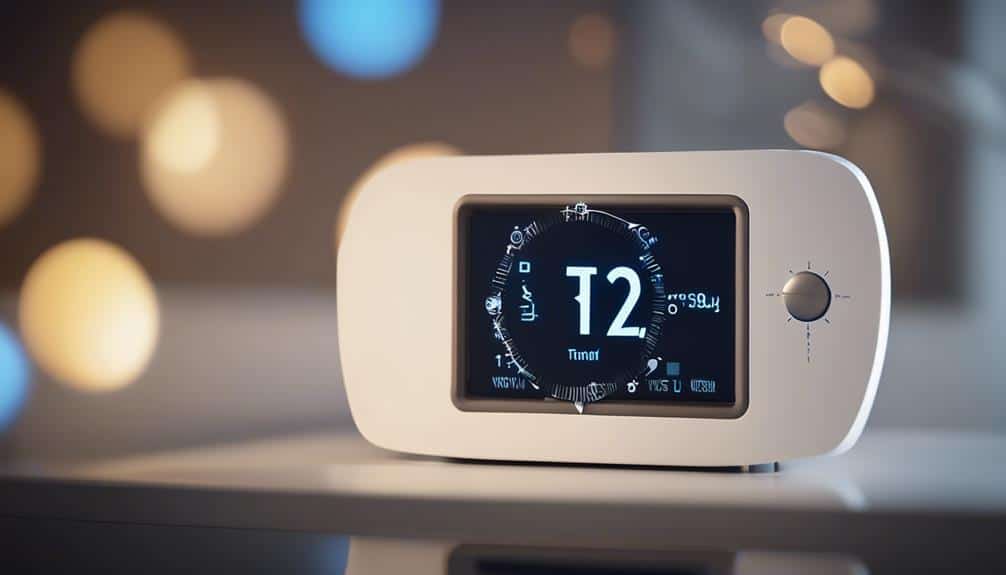
By adjusting your thermostat settings, you'll not only maximize energy efficiency but also enjoy savings on your utility bills. Personalizing your thermostat to find a balance between comfort and savings is key. Gradually acclimating yourself to the recommended settings can make these effective techniques feel more natural over time.
| Season | Setting for Savings |
|---|---|
| Summer | 78°F |
| Winter | Lower by 10-15°F for 8 hours |
| Away | Down by 7-10°F |
| General | Personalize for balance |
Embrace these strategies to not only enhance your energy efficiency but also tailor your environment for maximum comfort and savings. It's about finding what works best for you while keeping those bills in check.
Maximizing Energy Savings
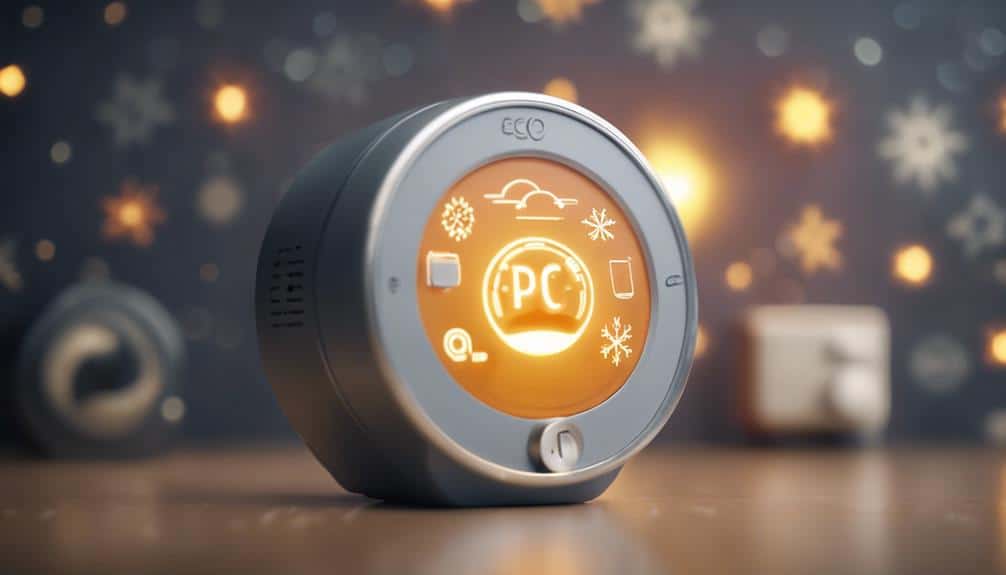
Having explored how to fine-tune your thermostat for both comfort and savings, let's now focus on additional steps you can take to amplify your home's energy efficiency.
Beyond just adjusting thermostat settings, you can greatly optimize energy consumption and contribute to sustainable living by:
- Incorporating smart thermostats for more precise temperature control and automated adjustments, even when you're away.
- Enhancing insulation to complement your HVAC system's efficiency, keeping warmth in during winter and heat out during summer.
- Scheduling regular maintenance for your HVAC systems to make certain they're running at their best, preventing energy waste and maximizing savings.
Frequently Asked Questions
What Is a Good Setting for Your Thermostat?
A good thermostat setting strikes a balance between energy savings and comfort. In winter, aim for warmth without cranking it up—think 68°F, using smart thermostats for night settings, and don't forget to wear layers!
What Should I Program My Thermostat To?
You should program your thermostat with smart scheduling for energy savings, set night settings for winter warmth, and use zone control. Don't forget manual override and vacation mode. Programmable options and adaptive learning optimize humidity control.
What Is the Most Efficient Thermostat Setting for Summer?
For the most efficient summer setting, aim for 78°F. You'll see energy savings by managing cooling cycles, using fan settings wisely, and adjusting for humidity control. Smart devices help, especially during peak hours, enhancing comfort and efficiency.
Is It Better to Keep Your Thermostat at a Constant Temperature?
It's not best to keep your thermostat constant. Adjusting for comfort balance, using smart devices, and managing temperature swings saves energy. Consider nighttime settings and vacation mode for more savings. Wear layers to adapt easily.
Conclusion
By optimizing your thermostat settings, you're not just saving money; you're also taking a step towards greener living. Embrace the ideal temperature range and make the most of programmable or smart thermostats. They're not just gadgets; they're tools for a healthier planet.
Mastering your thermostat and adopting effective techniques can greatly cut down on energy use. So, go ahead, fine-tune those presets, and enjoy the dual benefits of maximizing energy savings and contributing to a sustainable future.
